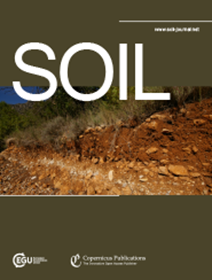混合信号:通过发光和数值模拟解读不同土壤生物扰动过程的混合模式
IF 5.8
2区 农林科学
Q1 SOIL SCIENCE
引用次数: 0
摘要
摘要土壤生物扰动在土壤功能(如碳和养分循环)中发挥着关键作用。尽管其重要性不言而喻,但有关生物扰动过程中不同生物和过程如何影响土壤混合速率和模式的基本知识却十分匮乏。然而,这些信息对于了解生物扰动对当今土壤功能和长期土壤演变的影响至关重要。发光是一种对光敏感的矿物特性,是土壤生物扰动的重要示踪剂。当土壤颗粒在土壤表面暴露于日光时,发光信号会重置(漂白),而当颗粒被埋入土壤中时,发光信号会累积,从而作为地下停留时间的代表。在这项研究中,我们汇编了不同生物群混合土壤的三个基于发光的数据集,并将它们与使用土壤-景观演变模型 ChronoLorica 进行的生物扰动数值模拟进行了比较。目的是了解不同的混合过程如何影响基于发光指标的深度剖面,如模态年龄、年龄分布宽度和漂白颗粒的比例。我们重点研究了两个主要的生物扰动过程:堆积(土壤物质向地表的平流迁移)和地下混合(地下扩散迁移)。每个过程对发光指标都有不同的影响,我们将其总结为一个概念图,以帮助对基于发光的深度剖面图进行定性解释。通过模型校准从荧光数据集中获取定量信息的首次尝试取得了可喜的成果,但也凸显了数据方面的差距,在对生物扰动速率和过程进行准确的定量估算之前,必须解决这些差距。随附的建模工具中提供了新的生物扰动数值公式,为校准和更准确地模拟土壤功能和土壤演变模型中的过程提供了新的可能性。本文章由计算机程序翻译,如有差异,请以英文原文为准。
Mixed signals: interpreting mixing patterns of different soil bioturbation processes through luminescence and numerical modelling
Abstract. Soil bioturbation plays a key role in soil functions such as carbon and nutrient cycling. Despite its importance, fundamental knowledge on how different organisms and processes impact the rates and patterns of soil mixing during bioturbation is lacking. However, this information is essential for understanding the effects of bioturbation in present-day soil functions and on long-term soil evolution. Luminescence, a light-sensitive mineral property, serves as a valuable tracer for soil bioturbation. The luminescence signal resets (bleaches) when a soil particle is exposed to daylight at the soil surface and accumulates when the particle is buried in the soil, acting as a proxy for subsurface residence times. In this study, we compiled three luminescence-based datasets of soil mixing by different biota and compared them to numerical simulations of bioturbation using the soil-landscape evolution model ChronoLorica. The goal was to understand how different mixing processes affect depth profiles of luminescence-based metrics, such as the modal age, width of the age distributions and the fraction of bleached particles. We focus on two main bioturbation processes: mounding (advective transport of soil material to the surface) and subsurface mixing (diffusive subsurface transport). Each process has a distinct effect on the luminescence metrics, which we summarized in a conceptual diagram to help with qualitative interpretation of luminescence-based depth profiles. A first attempt to derive quantitative information from luminescence datasets through model calibration showed promising results, but also highlighted gaps in data that must be addressed before accurate, quantitative estimates of bioturbation rates and processes are possible. The new numerical formulations of bioturbation, which are provided in an accompanying modelling tool, provide new possibilities for calibration and more accurate simulation of the processes in soil function and soil evolution models.
求助全文
通过发布文献求助,成功后即可免费获取论文全文。
去求助
来源期刊

Soil
Agricultural and Biological Sciences-Soil Science
CiteScore
10.80
自引率
2.90%
发文量
44
审稿时长
30 weeks
期刊介绍:
SOIL is an international scientific journal dedicated to the publication and discussion of high-quality research in the field of soil system sciences.
SOIL is at the interface between the atmosphere, lithosphere, hydrosphere, and biosphere. SOIL publishes scientific research that contributes to understanding the soil system and its interaction with humans and the entire Earth system. The scope of the journal includes all topics that fall within the study of soil science as a discipline, with an emphasis on studies that integrate soil science with other sciences (hydrology, agronomy, socio-economics, health sciences, atmospheric sciences, etc.).
 求助内容:
求助内容: 应助结果提醒方式:
应助结果提醒方式:


